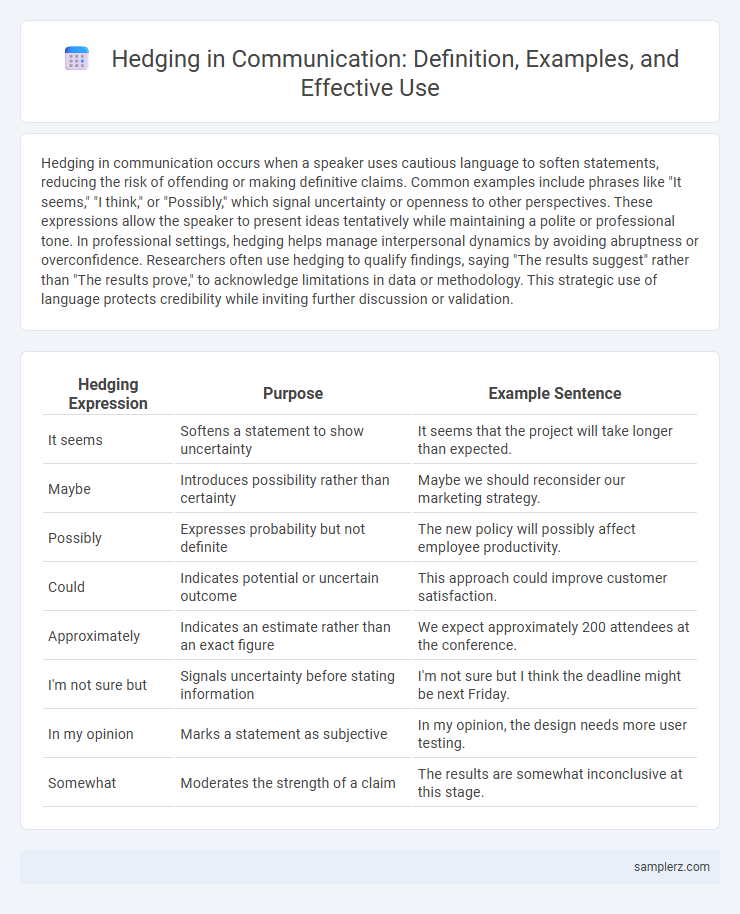Hedging in communication occurs when a speaker uses cautious language to soften statements, reducing the risk of offending or making definitive claims. Common examples include phrases like "It seems," "I think," or "Possibly," which signal uncertainty or openness to other perspectives. These expressions allow the speaker to present ideas tentatively while maintaining a polite or professional tone. In professional settings, hedging helps manage interpersonal dynamics by avoiding abruptness or overconfidence. Researchers often use hedging to qualify findings, saying "The results suggest" rather than "The results prove," to acknowledge limitations in data or methodology. This strategic use of language protects credibility while inviting further discussion or validation.
Table of Comparison
| Hedging Expression | Purpose | Example Sentence |
|---|---|---|
| It seems | Softens a statement to show uncertainty | It seems that the project will take longer than expected. |
| Maybe | Introduces possibility rather than certainty | Maybe we should reconsider our marketing strategy. |
| Possibly | Expresses probability but not definite | The new policy will possibly affect employee productivity. |
| Could | Indicates potential or uncertain outcome | This approach could improve customer satisfaction. |
| Approximately | Indicates an estimate rather than an exact figure | We expect approximately 200 attendees at the conference. |
| I'm not sure but | Signals uncertainty before stating information | I'm not sure but I think the deadline might be next Friday. |
| In my opinion | Marks a statement as subjective | In my opinion, the design needs more user testing. |
| Somewhat | Moderates the strength of a claim | The results are somewhat inconclusive at this stage. |
Understanding Hedging in Communication
Hedging in communication involves using cautious language to soften statements and avoid absolute claims, often seen in phrases like "It seems," "possibly," or "I believe." This strategy helps manage uncertainty, reduce potential conflict, and maintain politeness during conversations. Understanding hedging enables clearer interpretation of speakers' intentions and the subtle nuances behind their messages.
Common Phrases Used for Hedging
Common phrases used for hedging in communication include expressions like "it seems," "I think," "possibly," "in some cases," and "to a certain extent." These phrases help soften statements, making them less direct or assertive to avoid potential conflict or overcommitment. Hedging is frequently employed in academic writing, business discussions, and everyday conversations to introduce uncertainty or politeness.
Why People Use Hedging in Conversations
People use hedging in conversations to soften statements, reducing the risk of appearing overly confident or confrontational. Hedging helps manage interpersonal relationships by maintaining politeness and allowing room for alternative opinions or uncertainty. This communication strategy promotes cooperative dialogue and minimizes potential conflicts.
Hedging in Professional Communication
Hedging in professional communication often involves using phrases like "It seems," "Possibly," or "There might be" to soften statements and reduce the risk of offending or appearing overly assertive. This technique enhances collaboration by promoting open dialogue and allowing room for different interpretations or opinions. By strategically applying hedging, professionals can maintain politeness, manage uncertainty, and build consensus in workplace discussions.
Examples of Hedging in Academic Writing
Hedging in academic writing often involves the use of modal verbs such as "may," "might," and "could" to present claims with caution and avoid overgeneralization. Phrases like "it is possible that," "suggests that," and "appears to" help authors acknowledge uncertainty and allow room for alternative interpretations. These strategies improve the credibility of research by signaling tentativeness and promoting objective discourse in scholarly communication.
Cultural Variations in Hedging Strategies
Hedging strategies vary significantly across cultures, reflecting diverse communication norms and preferences. For instance, Japanese speakers frequently use indirect expressions and honorifics to soften statements, while English speakers may rely on modal verbs like "might" or "could" to express uncertainty. Understanding these cultural variations enhances cross-cultural communication effectiveness and reduces potential misunderstandings.
The Impact of Hedging on Message Clarity
Hedging in communication, such as using phrases like "I think," "possibly," or "it seems," can soften statements and reduce the risk of offending or appearing overly confident. While hedging may create ambiguity and diminish message clarity, it also allows speakers to express uncertainty and invite dialogue, which can be crucial in sensitive or diplomatic contexts. Balancing hedging techniques enhances effective communication by maintaining politeness without compromising the precision of the conveyed information.
Balancing Assertiveness and Hedging
Balancing assertiveness and hedging in communication involves using phrases like "I believe," "it seems," or "perhaps" to soften statements while maintaining confidence. This approach helps to present ideas with openness and flexibility, reducing the risk of appearing overly aggressive or uncertain. Effective hedging enhances dialogue by fostering collaborative and respectful exchanges, especially in professional or multicultural settings.
Misinterpretations Caused by Hedging
Hedging in communication, such as using phrases like "I think" or "maybe," can create ambiguity and lead to misinterpretations. When speakers hedge, listeners may perceive uncertainty or lack of confidence, causing confusion or misunderstanding of the intended message. Studies reveal that excessive hedging reduces clarity and can undermine effective information exchange in both personal and professional contexts.
Tips for Effective Hedging in Dialogue
Using hedging techniques like "I think," "perhaps," or "it seems" can soften statements and reduce the risk of conflict in sensitive conversations. Effective hedging encourages open dialogue by allowing speakers to express opinions without appearing overly assertive or confrontational. Mastering subtle language cues and maintaining a respectful tone improve clarity and foster collaborative communication.

example of hedging in communication Infographic
 samplerz.com
samplerz.com